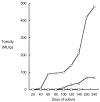Tetrodotoxin--distribution and accumulation in aquatic organisms, and cases of human intoxication
- PMID: 18728726
- PMCID: PMC2525488
- DOI: 10.3390/md20080011
Tetrodotoxin--distribution and accumulation in aquatic organisms, and cases of human intoxication
Abstract
Many pufferfish of the family Tetraodontidae possess a potent neurotoxin, tetrodotoxin (TTX). In marine pufferfish species, toxicity is generally high in the liver and ovary, whereas in brackish water and freshwater species, toxicity is higher in the skin. In 1964, the toxin of the California newt was identified as TTX as well, and since then TTX has been detected in a variety of other organisms. TTX is produced primarily by marine bacteria, and pufferfish accumulate TTX via the food chain that begins with these bacteria. Consequently, pufferfish become non-toxic when they are fed TTX-free diets in an environment in which the invasion of TTX-bearing organisms is completely shut off. Although some researchers claim that the TTX of amphibians is endogenous, we believe that it also has an exogenous origin, i.e., from organisms consumed as food. TTX-bearing animals are equipped with a high tolerance to TTX, and thus retain or accumulate TTX possibly as a biologic defense substance. There have been many cases of human intoxication due to the ingestion of TTX-bearing pufferfish, mainly in Japan, China, and Taiwan, and several victims have died. Several cases of TTX intoxication due to the ingestion of small gastropods, including some lethal cases, were recently reported in China and Taiwan, revealing a serious public health issue.
Keywords: gastropod; human intoxication; marine bacteria; newt; pufferfish; tetrodotoxin.
Figures




References
-
- Yokoo A. Chemical studies on pufferfish toxin (3) – separation of spheroidine. Nippon Kagaku Zasshi. 1950;71:590–592.
-
- Tsuda K, Ikuma S, Kawamura M, Tachikawa R, Sakai K, Tamura C, Amakasu D. Tetrodotoxin. VII. On the structures of tetrodotoxin and its derivatives. Chem Pharm Bull. 1964;12:1357–1374. - PubMed
-
- Woodward RB. The structure of tetrodotoxin. Pure Appl Chem. 1964;9:49–74.
-
- Goto T, Takahashi S, Kishi Y, Hirata Y. Tetrodotoxin. Tetrahedron. 1965;21:2059–2088. - PubMed
-
- Narahashi T. Pharmacology of tetrodotoxin. J Toxicol-Toxin Rev. 2001;20:67–84.
Publication types
MeSH terms
Substances
LinkOut - more resources
Full Text Sources
Medical
